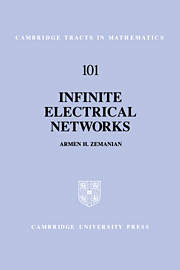5 - Transfinite Electrical Networks
Published online by Cambridge University Press: 05 February 2012
Summary
We have already seen that the idea of “connections at infinity” can be encompassed within electrical network theory through the invention of 1-nodes. A consequence is the genesis of transfinitely connected graphs, that is, graphs having pairs of nodes that are connected through transfinite paths but not through finite ones. An example of this is provided by Figure 3.4; there is no finite path connecting a node of branch a to a node of branch α, but there are 1-paths that do so. The maximal, finitely connected subnetworks of that figure are the 0-sections of the 1-graph, and the 1-nodes described in Example 3.2-5 connect those infinitely many 0-sections into a 1-graph.
There is an incipient inductive process arising here. Just as 0-nodes connect branches together to produce a 0-graph, so too do 1-nodes connect 0-sections together to produce 1-graphs. The purpose of the present chapter is to pursue this induction. While doing so, we will discover an infinite hierarchy of transfinite graphs. It turns out that most of the electrical network theory discussed so far can be transferred to such graphs to obtain an infinite hierarchy of transfinite networks. Thus, an electrical parameter in one branch can affect the voltage-current pair of another branch, even when every path connecting the two branches must pass through an “infinity of infinite extremities.”
To think about this in another way, let each 0-section of Figure 3.4 be replaced by replicates of the entire 1-graph of that figure.
Information
- Type
- Chapter
- Information
- Infinite Electrical Networks , pp. 139 - 157Publisher: Cambridge University PressPrint publication year: 1991
